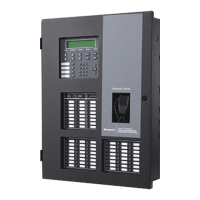Introduction
1-2
1. The system can have a maximum of 63 SBUS devices in any combination.
2. RA-1000 and RA-100 can have a maximum of 31 devices used.
1.1.2 Network System Hardware Features
• The default network setup can contain up to 32- IFP-2100/ECS / RFP-2100 panels connected.
• Network support for up to 32 Sites.
• Each building is referred to as a “site”.
• Panels can be interconnected using CLASS B or CLASS A topology.
• To network panels together use the SK-NIC network card. Copper wire or fiber optic cable panel
connectivity can be used within the same networked system.
• The network architecture provides true peer to peer capability allowing network survivability for all
hardware that remains operational in the event of partial system failure.
1.1.3 Software Features
• Advanced analog smoke detector features:
Three sensitivity settings (high, medium, low)
Automatic drift compensation
Maintenance alert region
Point status meets calibrated smoke test requirements for NFPA 72
Automatic day/night sensitivity adjustment
• “JumpStart AutoProgramming” feature for easy programming
• Non-volatile event history stores 1000 events per panel
• A choice of output patterns available for notification outputs, including ANSI 3.41 temporal signal
• Built-in synchronization appliance support for AMSECO, Gentex
®
, System Sensor
®
, and Wheelock
®
1.1.4 IFP-2100ECS Features
• 15 Recordable one minute messages that can be mapped to eight ECS buttons.
• ECS messages can be selected as priority over fire.
• Support of up to 15 ECS-LOC’s.
• Programmable trigger inputs from an external source, such as a Monaco system, to either the ECS-VCM,
ECS-NVCM, ECS-RVM, 5880, any SLC input module or Flexput module.
• Support for up to 16 SBUS addressable amplifiers using a combination of ECS-50W, ECS-125W, ECS-
INT50W or ECS-DUAL50W for a maximum of 2000 watts per system and up to 128 mappable speaker
circuits.
• Support for dual channel and backup audio using the ECS-DUAL50W amplifier and ECS-50WBU back-up
amplifier.
• Single enclosure for both Fire and Emergency Control System components.
• Support for one ECS-VCM or ECS-NVCM.

